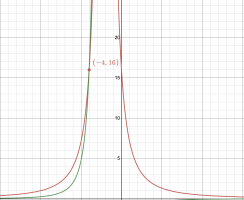RONJOHNSON
New member
- Joined
- Mar 3, 2022
- Messages
- 4
For homework, I was assigned a problem that read,
Find what the value of "a" is given that the tangent equation of f(x) = (x+2)2a is y = -2x+ 8.
What I did was:
f′(x)=(x+2)3−2a and then (x+2)2a=(x+2)3−2a
After simplifying that, I got x = -4.
I plugged that into y = -2x + 8 and got 16.
Then, since the point of tangency is equal to the tangent line and the original graph, 16=(0+2)2a.
This, of course, meant a = 64.
However, when we went of this in class, I found out that I was correct, but the teacher showed us a different way to do it. He set the deviate equal to the slope (-2), and then the tangent line with the original function, since x should have the same value when the y is the same. When you do a system of equations, you get x = 2. Plugging that into y = -2x + 8 gives you 4. Since this occurs at the same place as the original function, you can say 4=(2+2)2a. This, of course, also gives you a = 64.
My question is how come my first method worked. I don't see how I could set the original function equal with the derivative, and then plug that into the tangent line in a place that's not even the point of tangency?
Thank you!
Find what the value of "a" is given that the tangent equation of f(x) = (x+2)2a is y = -2x+ 8.
What I did was:
f′(x)=(x+2)3−2a and then (x+2)2a=(x+2)3−2a
After simplifying that, I got x = -4.
I plugged that into y = -2x + 8 and got 16.
Then, since the point of tangency is equal to the tangent line and the original graph, 16=(0+2)2a.
This, of course, meant a = 64.
However, when we went of this in class, I found out that I was correct, but the teacher showed us a different way to do it. He set the deviate equal to the slope (-2), and then the tangent line with the original function, since x should have the same value when the y is the same. When you do a system of equations, you get x = 2. Plugging that into y = -2x + 8 gives you 4. Since this occurs at the same place as the original function, you can say 4=(2+2)2a. This, of course, also gives you a = 64.
My question is how come my first method worked. I don't see how I could set the original function equal with the derivative, and then plug that into the tangent line in a place that's not even the point of tangency?
Thank you!

